Naming and Identity in Myths, Legends, Fairy Tales & Fantasy

To begin near the beginning: thename Adam was originally not a proper name at all. In his book The Five Books of Moses: A Translation withCommentary, the Hebrew scholar Robert Alter remarks of Adam’s firstappearance in Genesis 1.26:
The term ’adam,afterwards consistently used with a definite article, which is used both hereand in the second account of the origins of humankind, is a generic term forhuman beings, not a proper noun. It also does not automatically suggest maleness[...]. And so the traditional rendering “man” is misleading, and an exclusivelymale ’adam would make nonsense of thelast clause of verse 27:
AndGod created the human [the ’adam] inhis image,
in theimage of God He created him,
maleand female he created them.
In case you’re thinking, ‘Waita minute, there’s a ‘him’ right therein the second line,’ Alter adds:
In themiddle clause of this verse, “him”, as in the Hebrew, is grammatically but notanatomically masculine. Feminist critics have raised the question as to whetherhere and in the second account of human origins, in chapter 2, ’adam is to be imagined as sexuallyundifferentiated until the fashioning of woman, though that proposal leads tocertain dizzying paradoxes in following the story.
I love this and feel it couldwell be true: it’s a reminder that translating a word from one language toanother is often far from straightforward. In the second chapter of Genesis,God fashions the ’adam from the ’adamah (‘the human from the soil’: anetymological pun) like a potter moulding a figure out of clay. ‘A person’ in Frenchis une personne, grammaticallyfeminine even if the person in question is male. French la table is feminine while German der tisch is masculine, but no one thinks tables are male orfemale. Grammatical gender need not and often does not correspond to biologicalgender. In any case, a clay figure hasno biological gender. Whatever it lookslike, it is asexual.
Name-giving is an act of power, 'deep magic from the dawn of time' Even to speak is to exercise that power. Fewof us choose our own names; they are given by our parents when we’re so young wecan have no say in the matter, and as Adam and Eve ‘ruled’ over the animals, parents hold authority over their children. No matter how benevolent therelationship, this is probably why when children go to school, they often abbreviatetheir names or adopt nick-names. It’s a small act of self-assertion, part of thejourney towards detaching themselves from parental rule. To change your name isin some way to change yourself.
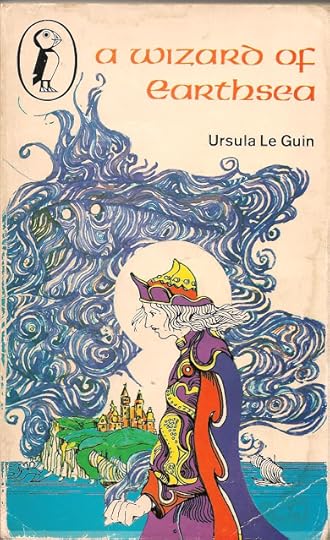
This brings me to the OldSpeech in Ursula Le Guin’s Earthsea series. In the first book, ‘A Wizard ofEarthsea’ (above, see my much-read copy of 1971) the hero Ged, whose use-name is Sparrowhawk (a true name is kept secret) arrives at the Wizards’ School onthe island of Roke to be sent with seven other apprentices to the Master Namer,Kurremkarmerruk, in the Isolate Tower.
Nofarm or dwelling lay within miles of the Tower. Grim it stood above thenorthern cliffs, grey were the clouds over the seas of winter, endless thelists and ranks and rounds of names that the namer’s eight pupils must learn.Amongst them in the Tower’s high room Kurremkarmerruk sat on a high seat,writing down lists of names that must be learned before the ink faded atmidnight leaving the parchment blank again.
Hard as this is, Ged does notcomplain. ‘He saw that in this dusty and fathomless matter of learning the truename of each place, thing and being, the power he wanted lay like a jewel atthe bottom of a dry well. For magic consists in this, the true naming of athing.’ He learns that the Old Speech is the speech of the Making, ‘thelanguage Segoy spoke who made the islands of the world’ and still spoken by dragons.We never learn much about Segoy, but in this origin myth it’s Segoy’s naming thatbrings Earthsea into existence – just as in the Book of Genesis, God brings theworld into existence.
Godsaid, ‘Let there be light,’ and there was light. [...] And God called the lightDay, and the darkness He called Night. And it was evening and it was morning,first day. And God said, ‘Let there be a vault in the midst of the waters, andlet it divide water from water.’ And God called the vault Heavens, and it wasevening and morning, second day. And God said, ‘Let the waters under theheavens be gathered in one place so that the dry land will appear.’ And so itwas. And God called the dry land Earth and the gathering of the waters Hecalled Seas...
In Genesis 2, in contrast tothe order of creation in Genesis 1, God creates animals after having created the ’adam,bringing each one of them to the human ‘to see what he would call it, andwhatever the human called a living creature, that was its name.’ It’s as though,having created human beings ‘in his own image’, God delegates the naming ofthings to them. There’s a strong hint that the naming of things – language – isan integral part of human ‘rule’ over animals. Names, or nouns, are single-word descriptions,the beginning of categorisation and a typically human and cerebral form ofknowledge. When in prehistory did spoken languages begin? Probably we’ll neverknow, but the Language of the Making , the Words of Creation – is a powerfulmyth.
In learning the true names ofthings, Ged gains power over them, a power that should be used sparingly and neverselfishly. He finds this out the hard way when prompted by pride and anger, hesummons by her name the spirit of beautiful Elfarran, a thousand years dead.And she appears.
Theshapeless mass of darkness he had lifted split apart. It sundered, and a palespindle of light gleamed between his opened arms, a faint oval reaching fromthe ground up to the height of his raised hands. In the oval of light for amoment there moved a form, a human shape: a tall woman looking back over hershoulder. Her face was beautiful, and sorrowful, and full of fear.
She is glimpsed only for amoment. Then the gap Ged has opened widens and rips ‘and through the brightmisshapen breach clambered something like a clot of black shadow, quick andhideous, and it leaped straight out at Ged’s face’, tearing and clawing him. Itcosts the life of the Archmage Nemmerle to close the gap, and for the rest ofthe book Ged is pursued by the shadow-beast he has let loose – until at last hehas the self-knowledge to claim this darkness as himself and calls it by his own name.
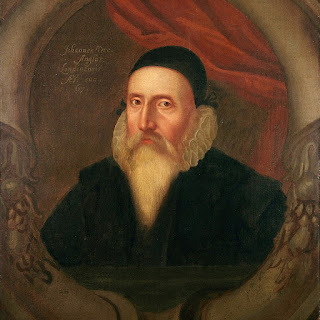
Many a medieval alchemist or renaissancedoctor attempted to conjure up spirits using what they conceived to be thepower of holy or unholy names. Katharine Briggs in ‘The Anatomy of Puck’ appendsa spell from Bodleian MS. Ashmole (1406) ‘To Call a Fairy’, parts of which run:
I.E.Acall the. Elaby: Gathan: in the name of the. father. of. the. son. and of theholy ghost. And. I Adjure. the. Elaby. Gathan: Conjure. and. Straightly.charge. and Command. thee. by. Tetragrammaton: Emanuell. Messias. Sether.Panton. Cratons. Alpah et Omega. [...] And. I. Conjure thee. Elaby. by. these.holy. Names. of God. Saday. Eloy. Iskyros, Adonay. Sabaoth. that thou appearpresently. meekely. and myldly. in this glasse. without. doeinge. hurt. or.daunger. unto. me. or any other. livinge. creature...
Knowledge of the fairy’s name wasonly half the battle: the magician clearly felt the need of divine protectionwhen it did appear.

An even more egregious example is given by Reginald Scot inhis scathing take-down of charlatans and superstition, ‘The Discoverie ofWitchcraft’ (1584). Of many examples, he includes a ‘prayer’ (!) forbinding and commanding angels ‘throwne downe from heaven’, which runs in part:
Irequire thee, O Lord Jesus Christ, that thou give thy virtue and power over allthine angels which were throwne downe from heaven to deceive mankind, to drawthem to me, to command them to do all they can, and that [...] they obeie meand my saiengs, and fear me. [...] and I require thee, Adonay, Amay, Horta,Vegedora, Mitai, Hel, Suranat, Ysion, Ysesy, and by all thy holie names [...]that thou enable me to congregate all thy spirits throwne down from heaven,that they may give me a true answer of all my demands, and that they satisfyall my requests, without the hurt of my bodie or soule, or anything that ismine...
The word ‘require’ in the late1580s hadn’t the force it has today; it meant something more like ‘request’ or‘desire’ – but this magician is clearly attempting to bend Christ to his willby the use of the various ‘holy’ names he attributes to him, and through Christto gain magical power over (and immunity from) devils. Talk about nerve! Someof the names look very made-up. ‘Vegedora’ sounds like a brand of softmargarine, but whatever is the Norse goddess of the underworld, Hel, doing in thatlist?
Besides summoning, itwas of course possible to banish or exorcise an evil spirit, if you knew itsname. In the Gospel of Mark, Chapter 5, Jesus casts out an ‘unclean spirit’from a madman who was living ‘among the tombs’ and whom no one could restraineven with chains, for he broke them all.
Whenhe saw Jesus from a distance, he ran and bowed down before him’ and he shoutedat the top of his voice, ‘What have you to do with me, Jesus, Son of the MostHigh God? I adjure you, by God, do not torment me.’ (For Jesus had already saidto him, ‘Come out of the man, you unclean spirit!’) Then Jesus asked him, ‘Whatis your name?’ He replied, ‘My name is Legion, for we are many.’ [...] Nowthere on the hillside a great herd of swine was feeding, and the uncleanspirits begged [Jesus], ‘Send us into the swine.’ So he gave them permission.And the unclean spirits came out and entered the swine, and the herd ... rusheddown the steep bank into the sea and were drowned.
In his book on the NewTestament, ‘Scripting Jesus’ (2010) L. Michael White points out that ‘the demonactually tries to exorcize Jesus bysaying, “I adjure you by God, do not torment me.” The word usually translated“adjure” here is the Greek orkizein(“conjure”), just as was used in demon spells.’ So, ironically, this demon tries calling onthe name of God to negate Jesus’ power. It is unable to resist when Jesusdemands its own name.
Given the belief that youcould conjure up demons or fairies by name, it’s unsurprising that magicalcharacters in fairy tales and folklore often keep their names secret. If they wereknown, others would wield power over them. In ‘The Water-Horse of Varkasaig’, a folktale from Skye, the dangerous water-horse is foiled of his prey (a youngmaiden) when the girl’s mother threatens to ‘cry his name to the four brownboundaries of the earth’ and to prove she can do it, whispers it in his ear. Onhearing it, with a terrible shriek the water-horse plunges into the river andvanishes.
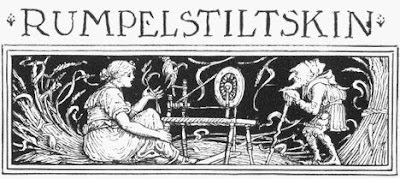
Rumpelstiltskin famously tearshimself in two with rage when the young woman whose straw he has spun into goldguesses his name. Variants of the story are found across Europe, and many’s thehero or heroine who manages to wriggle out of similarly unwise bargains. In his 'Teutonic Mythology' JacobGrimm tells how King Olaf of Norway (later Saint Olaf) hired a large troll or jøtun to build him a fine church on theagreement that once it was finished, his payment should be the sun andmoon, or else Olaf himself. Olaf set conditions which he thought the troll couldnot possibly meet: the church should be so large that seven priests couldpreach in it at once without disturbing one another, and the pillars andcarvings were all to be made from the hardest flint. But soon the church wasalmost finished, with only the roof and spire left to complete. Understandably worried,Olaf ‘wandered over hill and dale, when suddenly inside a mountain he heard a childcry and a troll-woman lulling it: “Hush, hush! Thy father, Wind-and-Weather,will come home in the morning, and bring you the sun and moon, or else SaintOlaf himself!”’ Hurrying home in delight, for ‘the power of evil beings ceaseswhen their name is known’, Olaf found the troll just placing the spire on theroof. ‘Vind och veder!’ he cried, ‘du har dat spiran sneder’ – ‘Wind andWeather! You’ve set the spire on crooked!’ – upon which the troll fell off theroof and burst into a thousand pieces. All variants include this accidentaloverhearing of the supernatural helper’s name. In a Danish version, St Olaf’srole is taken by one Esbern Snare, who hears a troll woman within a hillsinging:
‘Liestill, baby mine!
Tomorrow comes Fin, father thine,
Andgiveth thee Esbern Snare’s eyes and heart to play with.’
It’s possible to feel rathersorry for the trolls or imps who lose their labour (or lives!) in this way. Myfriend the writer Inbali Iserles has remarked of ‘Rumpelstiltkin’ that it is ‘astory where the greedy succeed, the victim is unsympathetic, and the villaincuriously wretched.’ But it’s hard to feel sorry for the gleeful little imp TomTit Tot, eponymous villain of the splendid Norfolk dialect version. After the Queenhas failed for the second time to guess its name (‘Is that Methuselem’ – ‘Noo,t’aint that neither’), the imp
looksat her with that’s eyes like a cool o’ fire, an’ that says, “Woman, there’sonly to-morrer night, an’ then yar’ll be mine!” n’ away te flew.
However the King her husband hasoverheard the imp’s name. Remarking casually to his wife that ‘I reckon Ishorn’t ha’ to kill you’ (seeing that she’s successfully spun the skeins eachnight so far), he sits down to supper with her and tells how out hunting hecame across a curious little black thing singing, ‘Nimmy nimmy not/My name’sTom Tit Tot’. Next day the Queen is well prepared:
[T]hat there little thing looked soo maliceful when he comefor the flax. An’ when night came she heerd that a knockin’ agin the winderpanes. She oped the winder, an’ that come right in on the ledge. That weregrinnin’ from are to are, an’ Oo! tha’s tail were twirling round so fast.
‘What’s myname?’ that says, as that gonned her the skeins.
‘Is thatSolomon?’ she says, pretending to be afeared.
‘Noo,t’ain’t,’ that says, and that come fudder inter the room.
‘Well isthat Zebedee?’ says she agin.
‘Noo,t’ain’t,’ says the impet. An’ then that laughed an’ that twirled that’s tailtill yew cou’n’t hardly see it. ‘Take time, woman,’ that says’ ‘next guess, anyou’re mine.’ An’ that stretched out that’s black hands at her.
Well, shebacked a step or two, an’ she looked at it, an’ then she laughed out, an’ saysshe, a pointin’ of her finger at it –
‘Nimmy nimmynot,
Yar name’s Tom Tit Tot.’
Wellwhen that hard her, that shruck awful an’ awa’ that flew into the dark, an’ sheniver saw it noo more.
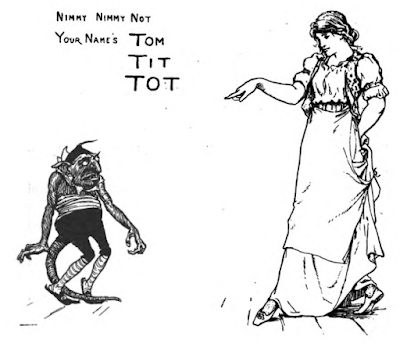
Characters in fairy tales areoften referred to either by generic descriptions (‘the king’sdaughter’, ‘the boy’, ‘the maiden’, and so on – or by the common names of whatevercountry the tale is set in, such as Hans, Klaus, Ivan, Kate, Jack. But many fairytale names are purely descriptive. Little Red-Cap or ‘Red Riding Hood’ is so calledafter her red head-wear. The faithful servant in ‘The Frog King’ is named IronHenry because ‘he had been so unhappy when his master was changed into a frog,that he had caused three iron bars to be laid round his heart, lest it shouldburst with grief’. The names Snow-White and Rose Red describe the innocence andbeauty of the characters, and ‘The Mastermaid’ is an apt description of the lively,clever, magic-working young woman of that Norwegian story.
Sometimes these names are insulting.Cinder-lad, Aschenputtel, Tatterhood, Dummling are given their names by familieswhich despise them: but since fairy tales always favour the underdog, we knowthey’re going to succeed. The princess known as ‘Allerleihrauh’ (All Kinds of Fur) escapes fromher incestuous father dressed in a cloak of, yes, all kinds of fur. ‘Coat o’Rushes’ disguises herself in a woven reed coat after her King Lear-like fatherthrows her out, and the princess in the Norwegian fairy tale ‘Katy Woodencloak’wears a clattering cloak of wooden laths. All three serve as kitchenmaids inthese guises, and all three restore their fortunes. The names derived fromtheir actions come to define them: ‘real’ names, if they had any, would besuperfluous. It’s all very existential.

As I’ve said above, to changeyour name is to change yourself. A sevenyear-old boy called Setanta son of Sualtim (his true father is Lugh of the LongHand, Irish god of light and war) kills Culainthe Smith’s savage guard-dog. When Culain complains, the boy offers to train upanother hound for him, until which time: ‘I myself will be your watch-dog, toguard your goods and your cattle and your house.’ Hearing this, Cathbad theDruid renames the boy.
‘I could have given no better award myself,’ said Cathbadthe Druid. ‘And from this out,’ he said, ‘your name will be Cuchulain, theHound of Culain.’ ‘I am better pleased with my own name of Setanta, son ofSualim,’ said the boy. ‘Do not say that,’ said Cathbad, ‘for all the men in thewhole world will some day have the name of Cuchulain in their mouths.’ ‘If thatis so, I am content to keep it,’ said the boy. And this is how he came by thename Cuchulain.
Cuchulain of Muirthemne tr. Lady Gregory,John Murray, 1907, 11
Cuchulain’s offer ofsubstitution – ‘I will be your watch dog’ – and his new name ‘Hound of Culain’ suggeststhat from now on dogs are Cuchulain’s kindred or totem. He is laid under two geasa: never to refuse a meal offered tohim by a woman and never to eat the flesh of a dog. At the end of his life,riding out to fight against Maeve’s great army, both geasa are used against him by three witches.
After a while he saw three hags, and they blind of the lefteye, before him in the road, and they having a venomous hound they were cookingwith charms on rods of the rowan tree. And he was going by them, for he knew itwas not for his good they were there.
But one ofthe hags called to him, ‘Stop a while with us, Cuchulain.’ ‘I will not stopwith you,” said Cuchulain. ‘That is because we have nothing better than a dogto give you,’ said the hag. ‘If we had a grand, big cooking hearth, you wouldstop and visit us, but because it is only a little that we have, you will notstop.’
…Then he went over to her, and shegave him the shoulder-blade of the hound out of her left hand, and he ate itout of his left hand. And he put it down on his left thigh, and the hand thattook it was struck down, and the thigh he put it on was struck through andthrough, so that the strength that was in them before left them.
Like the actions of thosefairy tale princesses Allerleihrauh, Katy Woodencloak andCoat o’ Rushes, Cuchulain’s boyhood decision to ‘become’ Culainthe Smith’s hound triggers his renaming, and changes the course of his life.Cathbad the Druid says, ‘All the men in the whole world will some day have thename of Cuchulain in their mouths.’ Cuchulain’s future identity as a hero issomehow bound up with his acceptance of this new name.
In Ursula le Guin’s collection‘Tales From Earthsea’ there’s a wonderful story called ‘Dragonfly’, about ayoung woman who travels to the Isle of Roke hoping to enter the School forWizards. Her use-name is Dragonfly, but the Doorkeeper asks for her true name –as he asks everyone who wishes for admittance – and her true name is one she’saccepted but has never felt really comfortable with.
‘Do you know whose name you must tell me before I let youin?’
‘My own,sir. It is Irian.’
‘Is it?’ hesaid.
That gaveher pause. She stood silent. ‘It’s the name the witch Rose of my village on Waygave me, in the spring under Iria Hill,’ she said at last, standing up andspeaking truth.
TheDoorkeeper looked at her for what seemed a long time. ‘Then it is your name,’he said. ‘But maybe not all your name. I think you have another.’
‘I don’t know it, sir.’ After anotherlong time she said, ‘Maybe I can learn it here, sir.’
Irian does not find her othertrue name here on Roke; but she does discover her true nature and her power:and when Thorion the Master Summoner (who is literally a dead man walking)attempts to bind her, he fails.
Slowly he raised his arms and the white staff in invocationof a spell, speaking in the tongue that all the wizards and mages of Roke hadlearned, the language of their art, the Language of the Making: ‘Irian, by yourname I summon you and bind you to obey me!’
She hesitated, seeming for a moment toyield, to come to him, and then cried out, ‘I am not only Irian!’
The Summoner lunges at her,running up on to Roke Knoll where all things become their true selves.
Theywere both on the hill now. She towered above him impossibly, fire breakingforth between them, a flare of red flame in the dusk air, a gleam of red-goldscales, of vast wings – then that was gone, and there was nothing there but thewoman standing on the hill path and the tall man bowing down before her, bowingslowly down to the earth, and lying on it.
Thorion’s return to deathrestores the Equilibrium, although from now on there will be a new balance.Irian departs ‘beyond the west’ to find the dragons, ‘Those who will give me myname. In fire, not water. My people.’ In dragon form she springs into the airand flies, and as ‘a curl of fire, a wisp of smoke’ drifts down through thedarkening air, the men stand silent, watching. ‘What now?’ asks her friend theMaster Patterner. And the Doorkeeper of the Wizards’ School on Roke answerssimply, ‘I think we should go to our house, and open its doors.’
It is the lastline of the story. And the story is all about difference. Who is Irian? Is she indeed a woman? Can you be twothings at once? What is her truth?
In the world of Earthsea asUrsula le Guin developed it over decades, humanity and dragons were once onekind, one kindred: the dragons were there at the beginning: the Eldest, bornknowing the True Speech. Then came the Division, the separation of dragons andhumans: but some still are of both kinds. Irian is not only such a one, she isalso female, a woman, considered by most of the Mages of Roke as less than aman. ‘I am not only Irian!’ she cries, refusing to be limited to a singleidentity. So yes, the story is about difference and prejudice, about names andthe changing of names and the discovering of new identities. And it asks us notto prejudge, but to accept and open our doors to those who come to us withtheir differences. I think it is good advice.
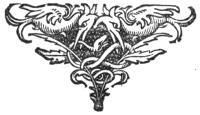
Picture credits:
Adam and Eve in the garden with God:Hieronymous Bosch, The Garden of Earthly Delights, c. 1490-1510
A Wizard of Earthsea, Penguin 1971, cover art &design Brian Hampton
Dr John Dee (1507-1608). Artist unknown, Ashmolean, Oxford, image from wikipedia
The Discoverie of Witchcraft, title page,British Library, image from wikipedia
Rumpelstiltskin: Walter Crane, 1886
Tom Tit Tot: English Fairy Tales by JosephJacobs, ill. John D Batten
Setanta Kills the Hound: ill. Stephen Reid, imagefrom wikipedia



